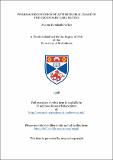Files in this item
Pharmacoeconomics of antimicrobial usage in the secondary care sector
Item metadata
| dc.contributor.advisor | Malek, M. (Mo) | |
| dc.contributor.author | Parker, Sharon Elizabeth | |
| dc.coverage.spatial | 329 p. | en_US |
| dc.date.accessioned | 2018-05-28T09:40:56Z | |
| dc.date.available | 2018-05-28T09:40:56Z | |
| dc.date.issued | 1998-02 | |
| dc.identifier.uri | https://hdl.handle.net/10023/13558 | |
| dc.description.abstract | With the advent of regular antimicrobial usage there has been recognition, worldwide, that they are overused and misused. The worries of inappropriate usage centre on increased antibiotic resistance with consequent loss of efficacy, unnecessary exposure to toxic side effects and latterly, financial waste. The two studies undertaken for this thesis have attempted to demonstrate how the combination of the costs of treatment with clinical and process measures of outcome could be used to avoid resource wastage. The first study was an audit of aminoglycoside utilisation and the general antibiotic management of gram-negative bacteraemia. The aminoglycosides were found to be poorly managed and associated with several opportunity costs. Three readily measurable indicators of adverse outcome of hospital antibiotic therapy associated with marked increases in hospital treatment costs were characterised. These were: Change to an alternative iv drug regimen, Retreatment with antibiotics in hospital, Readmission with infection. Another area of resource wastage was the excessive use of the intravenous route for antibiotic administration. Detailed feedback of these findings to selected clinicians was used in an attempt to heighten awareness to the management problems and associated cost of the aminoglycosides and to persuade prescribers to reduce the overall use of intravenous antibiotics by taking advantage of oral administration. The second study examined the feasability of non-inpatient intravenous (NIPIV) antibiotic care and compared the costs and benefits of this type of programme with traditional, hospital inpatient treatment. The study concluded that NIPIV care is feasible, appropriate criteria for patient selection were developed and provision of a quality service was shown to be practical. The issue of safety was raised; as a result, the notion of 'acceptable risk' deserves exploration in the further development of NIPIV care. Sensitivity analysis was used to explore the bias introduced to the costings in this study by commercial sponsorship. | en_US |
| dc.language.iso | en | en_US |
| dc.publisher | University of St Andrews | |
| dc.subject.lcc | RS431.A6P2 | |
| dc.subject.lcsh | Antibiotics | |
| dc.title | Pharmacoeconomics of antimicrobial usage in the secondary care sector | en_US |
| dc.type | Thesis | en_US |
| dc.type.qualificationlevel | Doctoral | en_US |
| dc.type.qualificationname | PhD Doctor of Philosophy | en_US |
| dc.publisher.institution | The University of St Andrews | en_US |
This item appears in the following Collection(s)
Items in the St Andrews Research Repository are protected by copyright, with all rights reserved, unless otherwise indicated.

